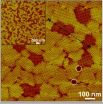The discovery could have major implications for multiple sclerosis, complications from premature birth and other disorders and diseases caused by demyelination – a process where the insulation-like sheath surrounding nerve cells in the brain becomes damaged or destroyed. Demyelination disrupts the ability of nerve cells to communicate with each other, and produces a range of motor, sensory and cognitive problems in MS and other disorders.
The study was published this week in the online edition of the Annals of Neurology. The study was conducted by a team of researchers led by Larry Sherman, Ph.D., who is a professor of cell and development biology at OHSU and a senior scientist in the Division of Neuroscience at the Oregon National Primate Research Center.
"What this means is that we have identified a whole new target for drugs that might promote repair of the damaged brain in any disorder in which demyelination occurs," Sherman said. "Any kind of therapy that can promote remyelination could be an absolute life-changer for the millions of people suffering from MS and other related disorders."
Sherman's lab has been studying MS and other conditions where myelin is damaged for more than 14 years. In 2005, he and his research team discovered that a sugar molecule, called hyaluronic acid, accumulates in areas of damage in the brains of humans and animals with demyelinating brain and spinal cord lesions. Their findings at the time, published in Nature Medicine, suggested that hyaluronic acid itself prevented remyelination by preventing cells that form myelin from differentiating in areas of brain damage.
The new study shows that the hyaluronic acid itself does not prevent the differentiation of myelin-forming cells. Rather, breakdown products generated by a specific enzyme that chews up hyaluronic acid – called a hyaluronidase – contribute to the remyelination failure.
This enzyme is highly elevated in MS patient brain lesions and in the nervous systems of animals with an MS-like disease. The research team, which included OHSU pediatric neurologist Stephen Back, M.D., and OHSU neuroscientist Steve Matsumoto, Ph.D., found that by blocking hyaluronidase activity, they could promote myelin-forming cell differentiation and remyelination in the mice with the MS-like disease. Most significantly, the drug that blocked hyaluronidase activity led to improved nerve cell function.
The next step is to develop drugs that specifically target this enzyme. "The drugs we used in this study could not be used to treat patients because of the serious side effects they might cause," said Sherman. "If we can block the specific enzyme that is contributing to remyelination failure in the nervous system, it would likely cause few, if any, side effects."
Sherman and other researchers at the ONPRC are uniquely positioned to test newly developed drugs for their safety and effectiveness in nonhuman primates at ONPRC that spontaneously develop an MS-like disease. If they find a drug that is effective in these monkeys, they will be in a good position to test such drugs in patients.
Sherman cautioned that the discovery does not necessarily signal a cure for MS. Many other factors can contribute to the problems associated with MS and other demyelinating diseases, he said. But discovering the actions of this enzyme — and finding a way to block it — "could at the very least lead to new ways to promote the repair of brain and spinal cord damage either by targeting this enzyme alone or by inhibiting the enzyme in conjunction with other therapies."
INFORMATION:
The research was supported by grants from the National Institutes of Health, Fast Forward, LLC (a subsidiary of the National Multiple Sclerosis Society), the Laura Fund for Multiple Sclerosis Research, the March of Dimes Birth Defects Foundation and the American Heart Association.
About OHSU
Oregon Health & Science University is a nationally prominent research university and Oregon's only public academic health center. It serves patients throughout the region with a Level 1 trauma center and nationally recognized Doernbecher Children's Hospital. OHSU operates dental, medical, nursing and pharmacy schools that rank high both in research funding and in meeting the university's social mission. OHSU's Knight Cancer Institute helped pioneer personalized medicine through a discovery that identified how to shut down cells that enable cancer to grow without harming healthy ones. OHSU Brain Institute scientists are nationally recognized for discoveries that have led to a better understanding of Alzheimer's disease and new treatments for Parkinson's disease, multiple sclerosis and stroke. OHSU's Casey Eye Institute is a global leader in ophthalmic imaging, and in clinical trials related to eye disease.
About Fast Forward, LLC
Fast Forward, LLC, is a nonprofit organization established by the National Multiple Sclerosis Society in order to accelerate the development of treatments for MS. Fast Forward accomplishes its mission by connecting university-based MS research with private-sector drug development and by funding small biotechnology/pharmaceutical companies to develop innovative new MS therapies and repurpose FDA-approved drugs as new treatments for MS. More information can be found at www.fastforward.org.
About The National Multiple Sclerosis Society
The National MS Society addresses the challenges of each person affected by MS. To fulfill this mission, the Society funds cutting-edge research, drives change through advocacy, facilitates professional education, collaborates with MS organizations around the world, and provides programs and services designed to help people with MS and their families move forward with their lives. In 2011 alone, through its national office and 50-state network of chapters, the Society devoted $164 million to programs and services that assisted more than one million people. To move us closer to a world free of MS, the Society also invested $40 million to support more than 325 new and ongoing research projects around the world. The Society is dedicated to achieving a world free of MS. Join the movement at www.nationalMSsociety.org.
END




